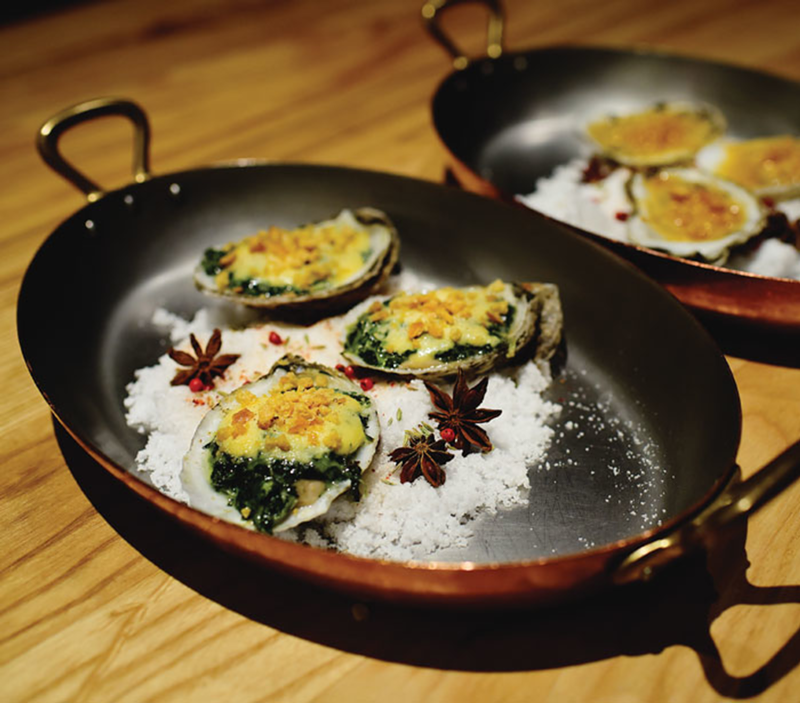O
ysters and oyster stew aren’t what you would usually expect to see on an American Christmas dinner table, but, as it turns out, the briny bivalves have a long holiday tradition in Cincinnati.
The popularity of oysters in the Queen City started with an influx of European immigrants in the 19th century, especially Irish and German Catholics. Both followed religious dietary restrictions around the holidays, i.e., no meat on Christmas Eve, so instead they ate fish. The Irish traditionally prepared a fish called “ling” during the holidays, which they stewed with milk, butter and pepper. Since there was no ling in America, they substituted oysters, and thus the traditional warm and comforting Christmas Eve oyster stew was born.
People freaking loved oysters in the 1800s. In fact, Americans harvested 700 million of the little suckers out of the Hudson Bay in 1880 alone. Cincinnati even had an Oyster Line — a stagecoach that ran from 1835 to 1850 and carted fresh oysters on ice on a five-day trip from Baltimore to supply the city’s
various oyster houses.
Historically, Cincinnati restaurants served oysters baked in shells, in pies, raw, stewed with champagne, fried, pickled and even in aspic, according to local historian Dan Woellert’s book, Historic Restaurants of Cincinnati: The Queen City’s Tasty History. And when Cincinnatians couldn’t get their hands on oysters, they used pickled pigs’ feet instead, which were then referred to as “Cincinnati oysters.”
And Christmas oysters are still a restaurant mainstay today. The Anchor-OTR, The Precinct and Boca in particular serve up this unexpectedly popular celebration dish during the holiday season and up to New Year’s Eve.
At Boca, executive chef Jeremy Lieb has created a new menu comprised of raw and hot oysters, with fresh picks updated regularly. Guests are allowed to mix and match their individual favorites nightly, and on Wednesday evenings between 5 and 6:30 p.m., a half-dozen oysters are half-price.
This menu has a combination of oyster preparations sourced from both the West Coast and East Coast. The West Coast oysters include Shigoku with horseradish or yuzu kosho ($5.50 each), and Kusshi with the same ($4.50 each). The East Coast oysters are topped with miso butter or are Rockefellered ($4.50). The Oysters Rockefeller — topped with spinach and hollandaise — is a staple of both the main Boca menu and oyster menu, and this particular selection will be in rotation for the foreseeable future.
Lieb is also looking to overcome any stigma about when to eat oysters. “The old saying is not to eat them in months that don’t end with R,” he says. “But that’s not really a problem because the oysters that are used aren’t wild anymore.”
This original belief about only eating oysters in months with an “R” — aka not during the warm months of May, June, July or August — came from food-safety threats of red tide blooms and before the advent of reliable refrigerated transport. Oysters today are commercially farmed, so they don’t face the same contamination issues.
Lieb, who has lived and cooked all over the world, says that people often lose sight of what’s important when it comes to cooking oysters and wants to bring the attention back to the craft itself. Although he prefers the West Coast oysters, and serves them cold, he appreciates the nuanced layers of flavor when it comes to East Coast oysters. “They’re bigger, crispier, firmer and brinier,” he says.Other restaurants in the downtown area are also keeping up the Cincinnati holiday tradition. Anchor-OTR serves both East Coast and West Coast oysters in their oyster bar all week long. During their 5-7 p.m. happy hour, oysters are only $1.50, and every Thursday they have Oyster Mania. That means $1 oysters, $1 cans of Tecate and $6 martinis all night long — and both Christmas Eve and New Year’s Eve happen to fall on Thursdays this year.
Meanwhile, Jeff Ruby’s The Precinct, although mostly known as a steakhouse, has its own oyster selection and raw bar, with Oysters Rockefeller as an appetizer ($22.75) and raw Virginia Blue Point oysters ($3.25 each).
Historic local saloon Washington Platform, a 19th-century gathering spot for German immigrants, also has a popular workingmans oyster selection (and an entire oyster festival serving up every preparation imaginable starting at the end of March).
At the platform, you can always get a traditional Cincinnati oyster stew (fresh oysters with milk, spices and a slice of garlic toast; $11), plus myriad oyster dishes like shooters ($12), oysters on the half-shell ($11-$19) and even oysters fried in cornmeal breading ($25).
Although, along with Boca, these restaurants might put a little dent your wallet, there’s nowhere better to find oysters during the Christmas season. And if you’re staying in, there’s no better way to celebrate Cincinnati’s Christmas roots than with oyster stew.


